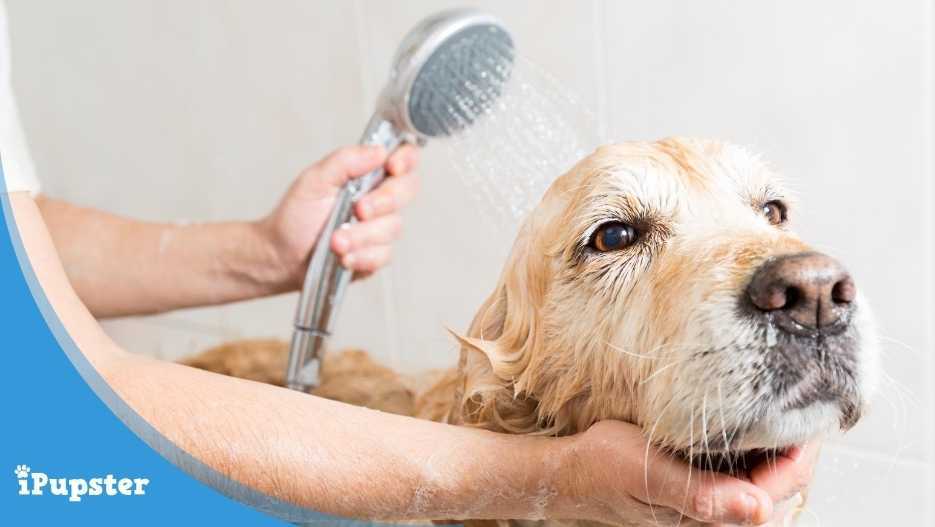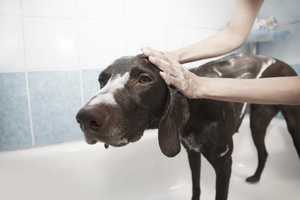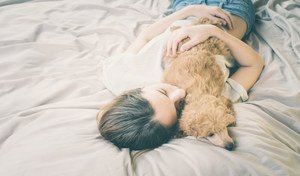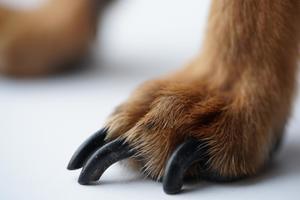There is a lot to learn - and to do - when you welcome a new dog into your family.
What to feed your dog, how to train her, what are the best dog toys you can buy to keep her happy and amused? What health problems should you be on the lookout for?
And, something that can get overlooked all too often, how to bathe and groom them.
Why Groom Your Dog Yourself
Years ago, there was a notion among many dog owners that dog grooming was just something reserved for pups whose owners wanted them to 'look fancy'.
The fact is though that bathing and grooming your pup is important for their health.
Yes, it's great when your pup looks good too, but regular bathing and grooming is more about keeping their skin and fur healthy, their teeth clean and free of disease, their coat free of tangles (and pests) and other concerns (that we'll discuss here) that are more about your pup's health and well-being than their looks.
While you could leave all your pup's bathing and grooming to a professional (and admittedly some people do) there are a number of good reasons to take the information and advice in this guide and get into the habit of doing it yourself.
Some dogs hate going to the groomers as much as the hate going to the vet. This does not make for a happy experience for anyone involved and going through it regularly will be pretty stressful for everyone (especially your pup).
Groomers aren't cheap
Finding a good groomer can be hard, and choosing the wrong one can, sadly, be disastrous. We're not just talking a bad trim, but actual physical harm.
Don't get us wrong. There are some amazing dog groomers out there and for special occasions a trip to one of them might be a treat for your pup. A bit like your trips to the hair salon/spa. But we doubt you go to the spa every time you personally need a bath or shower or wait until your next dentist's appointment to brush your teeth!
So, a little DIY dog grooming is never a bad idea.
It's for this reason that we have come up with this guide to everything you need to know about keeping your pup clean and well groomed. So, let's dive right in.
Dog Washing Guide
Lots of dogs love water. They love to swim in it, wade through it and even just paddle in a dog pool. Bathe in it? Although there are some canine fur kids who love to take a bath there are just as many (if not more) who hate the idea.
Nevertheless, bathing your pup is very important!
Giving your dog a bath helps remove loose skin - which can be very itchy for them and impede coat growth - and help prevent skin irritations which can certainly be very uncomfortable and can lead to your dog scratching themselves so much that they cause self injury.
Then there is the odor factor. Dogs get into lots of 'things', especially when they go outside (not to mention rolling in their own poop!), and the result can be pretty stinky.
A nice bath will leave them smelling clean and fresh again, which is better for them and for your home!
How Often To Bathe a Dog at Home?
Unlike humans, dogs do not need a lot of baths. They do wash themselves, and for the most part do a good job. So bathing is only an occasional thing, maybe once every few months.
The ASPCA recommends bathing your pup at least once every three months.
Unless, of course, they roll in something nasty and need to be cleaned up right away. Bathe a pup too often and her skin may get too dry.
One more important note about odors. Occasionally a bad smell emanating from your pup is not because he's been playing where he should perhaps not have been but a sign of ill health.
All dogs have a natural smell - and that's normal - but if you notice a new odor that does not go away, even after a bath, then you should book a checkup with your vet to rule out any medical cause.
Where Should You Bathe Your Dog?
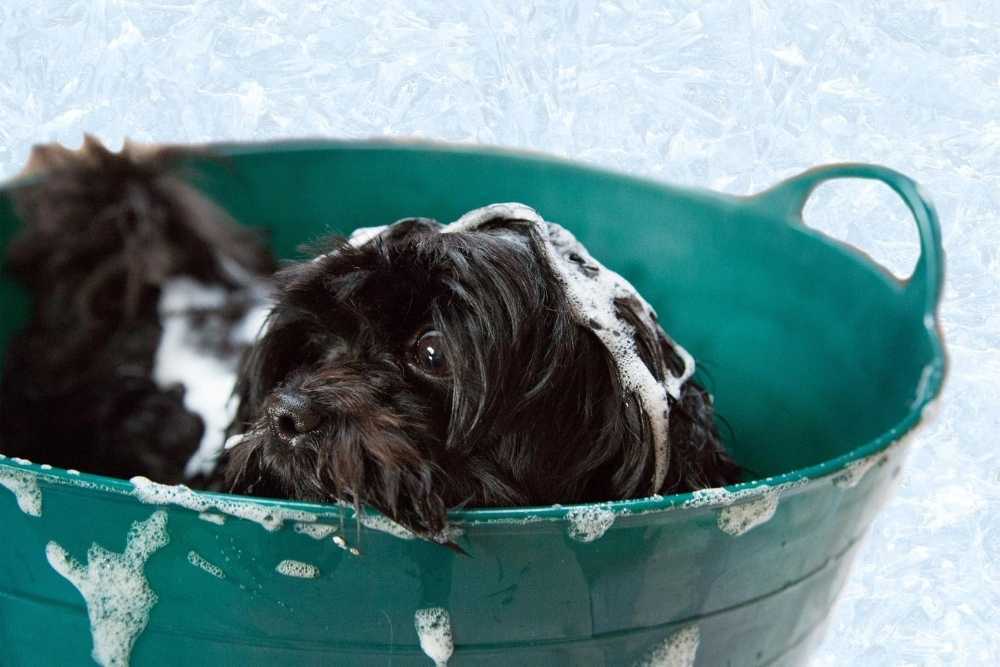
Where bath time should take place can be tricky and depends very much on the size of your pup, his general attitude towards bathing and the space you have to work with.
With these things in mind here are some of the most commonly used options.
1. Use a hose bath
Making use of a low-pressure garden hose is one way to bathe larger pups or those who simply won't stay in a tub or wading pool. Here are some tips for a safe hose bath your dog (might) enjoy.
Make sure you have plenty of room to set up your 'pup washing station' in an area that is enclosed. If a puppy is not fond of water she may bolt when it hits, so make sure that she is safely enclosed. A fenced in yard is ideal.
Ensure that you really do make use of a low-pressure hose. High-powered water jets can cause serious injury. If you can't reduce the pressure on your standard hose, consider making use of a handheld shower instead.
Assemble everything you need beforehand, so that you don't need to leave your dog alone once bathing has begun.
Before you wet your dog or puppy test the water temperature. It should be lukewarm, never too hot and never too cold.
2. In An Indoor Bath
If your dog is not too averse to bathing, and is small enough to fit, you can make use of your own bathtub. Some pet parents do find that this is a better way to bathe even a bath shy dog as they can be enclosed in a bathroom and kept safe.
Bathing a dog indoors is much the same as bathing a human kid.
However, remember that your dog is more likely to jump out of the bath than a toddler, so make sure that the area around the bath is clear.
3. Build a Dog Bathing Station
If yours is a dog that likes to get muddy and messy a lot, and you have the space in a garage or shed, or even an area of your yard you can designate, you could consider building a DIY dog washing station.
This video explains how to make one reasonably easily and inexpensively.
4. Get Professional Help
There are some dogs that just hate bathing and will do almost anything to avoid taking one (including destroying your bathroom and, in some cases, even become unusually stressed out and/or aggressive).
In this case bathing really is best left to a good professional dog groomer, to avoid causing stress for you, your pup and damage to your home.
What You Need To Groom Your Dog at Home
As we mentioned earlier, you should make sure that you have all the supplies needed to bathe your dog assembled and ready to go beforehand.
But what should those be?
Here's a checklist.
1. Brush
Before bathing you should brush your pup to remove as many tangles and as much loose hair as possible.
The best dog brushes are firm, but not too firm and properly sized for your pup.
We like the Hertzko Self Cleaning Slicker Brush. It’s nicely sized for use on pups of all sizes, simple to operate and to clean. It’s also ergonomically designed to prevent hand fatigue, however long you brush your pup.
2. Towels
Yes, dogs can shake dry themselves but to stop them from getting too cold or drenching the bathing area keep a supply of towels on hand to fry them off with when you are done.
These should not be towels you will be upset about getting damaged, so your best bath towels are out! Give your dog his own dog towel with the DII Bone Dry Microfiber Dog Bath Towel that comes with an embroidered paw print.
It’ll get the job done and it's long lasting.
3. Dog Shampoo
There are Llots of different dog shampoos available, as you’ll quickly find out if you are shopping for one for the first time.
Pro Tip: We wrote an in-depth guide into the best dog shampoos and conditions found here.
What should you look for in a dog shampoo?
Here are some pointers:
Hypoallergenic
Dogs should not be bathed using human shampoo.
One of the biggest reasons for this warning is that the majority of human shampoos contain additives, color and fragrance that often irritate a pup’s sensitive skin and can even dull his coat.
By choosing a hypoallergenic dog shampoo that is as additive free as possible you’ll help your pup feel better and look great after a bath while getting him clean effectively.
Sulfate Free
You have probably heard that, as a human, your own hair will look better if you choose a shampoo that’s sulfate free. The same is true for dogs.
Sulfates are cleansing agents that are used not only in shampoos but also dish washing liquid and even car washing soaps.
This means that they can easily strip away essential oils from dog’s fur, leaving it dull, quicker to attract dirt and even irritated.
One thing to note: Part of the reason that sulfates are added to shampoos is to get that ‘big lather’ effect most people associate with hair washing. However, that’s not an indication that a shampoo is working better.
Sulfate free shampoos produce a lot less lather, which may be concerning to you at first but they are getting the job done, just without as many artificial bubbles!
Conditioning
Choosing a dog shampoo that conditions as it cleans is a good idea too, as that will help their coat look shinier, and less like to tangle, once their bath is done.
Pleasant Smelling
We all know that dogs are super sensitive to odors, so if a shampoo smells too harsh or chemically it may upset them (and stink out your bathroom too).
Some pet shampoos make use of the concept of aromatherapy and add things like lavender or chamomile essential oils as these have a reputation (which is actually backed research) as calming agents, even for dogs.
Keeping all these things in mind our personal choice for our fur kids is Wahl 4 in 1 Calming Dog Shampoo. It’s additive free, sulfate free and contains both lavender and chamomile extracts for that extra calming effect.
It’s widely used by professional groomers, yet available inexpensively to pet parents too and comes from a name that’s been a leader in human hairdressing for decades!
4. Washcloths
The one thing you should not do is spray water directly on your dog’s head (we’ll discuss why not in greater detail soon.)
Keep a few washcloths on hand so you can wash their face and ears using that instead.
5. Treats
You do want your pup to enjoy her bath as far as possible. The thought of getting rewarded with a treat or two for behaving in the bath is a big motivator for some pups, and even if your dog is one that likes bathing a treat at the end of the process can never be a bad thing.
6. Slip Mat
Just like you, your pup may slip when getting out of a bathtub, whatever kind you might be making use of. And, if there is splashing involved the floor may end up wet enough to trip you as well!
Place a non-slip mat in front of the tub to help keep both you and your fur kid on your feet!
How To Bathe a Dog at Home
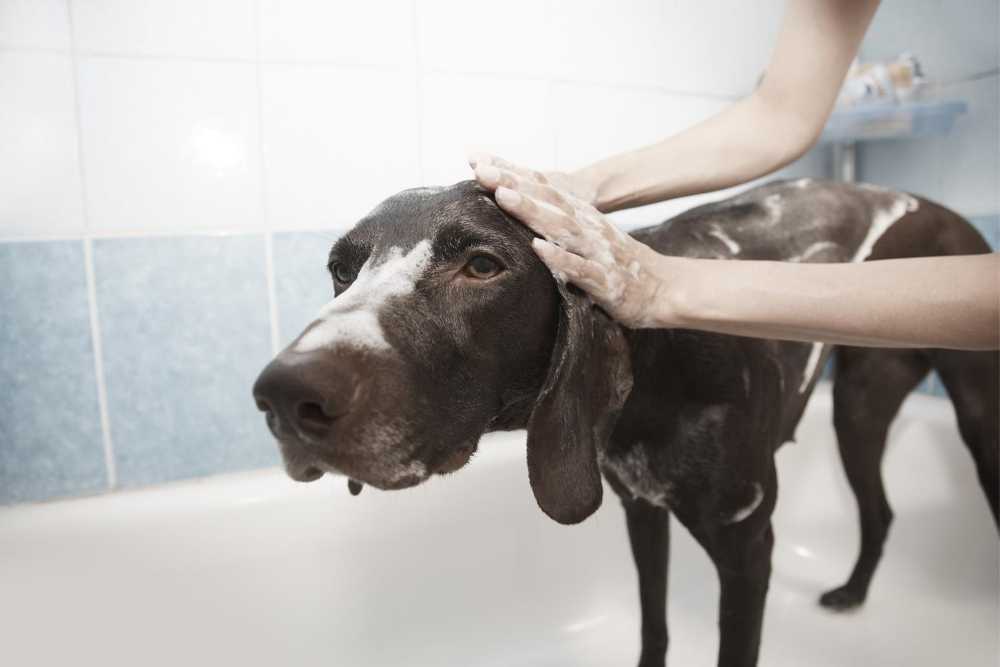
Once you have decided on a bathing location, and have assembled all your supplies, it will finally be time to start bathing your pup.
This does have to be done carefully and with some thought, especially if this is the first time you will be attempting to wash your dog yourself.
Dogs traumatize easily, and remember traumas for a long time, so the better her first bath time goes the more likely she is to be happy to do it again.
To help you, here is a simple step by step guide to bathing your dog the right way.
Step 1
Ensure that you have assembled all the supplies you’ll need close to hand. Try to arrange things so that you will be able to pick up/put down supplies and remain near your pup (as your close presence will make a big positive difference.)
Step 2
Before your do anything else, start by showing your pup some extra love. Pet and stroke her – and maybe even offer her a ‘pre bath’ treat and thank her in advance for being good at bath time!
This will help keep her calm, as most dogs, even if they have never been formally bathed before tend to know ‘something’ is coming (much as most pups sense when a car ride is leading them to the vet, not a fun dog park.)
Next, brush her gently to loosen any hair that can be and to brush away loose dead skin.
Step 3
Ensure that the water is at the right temperature. Test it in the same way you might a baby’s bathwater by running it on the inside of your wrist to ensure it’s neither too hot nor too cold. Run it for a few minutes to help ensure that there are no hot or cold surges as the water flows.
If you are making use of a hose outdoors ensure the pressure is nice and low, and the same is true if you are using a handheld shower. You may like the ‘super pulse’ feature on your personal shower but most dogs won’t.
Step 4
Place, or encourage your dog to climb into the tub – if you are using one versus the ground – praising her for doing so and yes, maybe even offering a treat as a reward once she’s in the right spot. Keep petting her, especially if she seems nervous or upset.
Wet your dog’s body. Do not wet his head. Even the best behaved of pups often see direct unexpected contact with their head as a threat and may become scared and aggressive.
Do so in sections, not all at once, as a quick ‘drenching’ may be faster but it’s almost certainly going to upset your pup!
Step 5
Shampoo time! Start at your pup’s chest and gently massage in your chosen dog shampoo all over her body, including her legs and feet. Wet a washcloth and gently dampen your pup’s head and ears. Add a very small amount of shampoo with your fingers, being careful to avoid her eyes.
Even hypoallergenic dog shampoo may sting a little. If you do accidentally get shampoo in her eyes rinse it away with cool clear water as quickly as you can without alarming your pup further.
Step 6
After the shampoo is nice and soapy praise your pup again and then slowly begin rising it off. Remember, do not use the shower head/hose to rinse the shampoo from her head, you should do that, slowly, using your hands and the washcloth. Make sure that you rinse out all the shampoo, as leaving any behind will dull your pup’s coat.
Some pet parents whose dogs have very think fur may choose to use a separate dog conditioner. It’s not a must, and most dogs are fine without one, but if you choose to do so you should repeat steps 2-5 using the conditioner.
A better idea may be to add a leave in conditioner.
Yes, they do make them for dogs too, and while there are quite a few available we personally recommend Warren London hydrating butter leave in conditioner for dogs. It will leave your pup’s coat shiny and tangle free but you won’t have to struggle through an additional rinsing process.
Step 7
After (excessively) praising your pup for being so good in the bath help/encourage them to get out of the tub and then gently blot them dry with a towel.
Never use a hair dryer as that can lead to some very nasty burns and, in some rare but tragic cases has been known to kill a smaller dog. Once they are reasonably dry let them go play or do whatever makes them happy, as they’ve earned it!
How To Groom a Dog Yourself
For most pups brushing and grooming their coat is something that should be done more frequently than taking a bath. In the case of puppies, brushing should be a daily occurrence.
If your pup has very long, or dense, fur then you probably know this, as failing to brush this kind of dog coat results in mats and tangles and no one wants that, especially not your pup.
But the fact is that even short haired pups need to be groomed occasionally.
Even if they don’t have much fur to shed, they will have dead skin that brushing will loosen and remove.
Why You Should Groom Your Dog?
Just like bathing, failing to brush your dog at least occasionally can be detrimental to their health. Knots and mats in their coat can do more than spoil your pretty pup’s good looks.
If they are allowed to worsen moisture can become trapped between them and the skin, leading to skin irritations and infections. Dead skin can even become troublesome for short haired dogs, so really does need to be removed. Regular brushing will do just that.
What Is the Best Brush for Grooming a Dog?
There are tons of dog brushes and ‘dog grooming systems’ available so if you are confused about which of them is right for your dog then it’s no surprise.
Different dogs will benefit from different brush styles, so it’s hard to make a one size fits all product recommendation. If you have a dog with lots of hair that tends to tangle and mat then you will need a brush that can handle that without tearing at your dog's coat or calling for you to brush too hard.
The Furminator deshedding tool is a very popular choice with even professional dog groomers as its rake like teeth can cut through dense hair and tangles safely and easily but then can be used as a standard brush as well.
If your dog has shorter hair, a tool like the Furminator may be too harsh. Choose a natural bristle brush – boar bristles are great – like the Conair PRODOG Pet-it – as that will loosen hair and dead skin without being too harsh on their skin, which is a lot more exposed than it is on a long-haired dog.
Most dogs eventually become used to being brushed, but there are a few that really don’t like it. If that turns out to be the case for your dog a grooming glove, like this one, can be a way to ‘trick’ her into being groomed as essentially you will be petting her rather than brushing her!
Do Yourself Dog Grooming Instructions
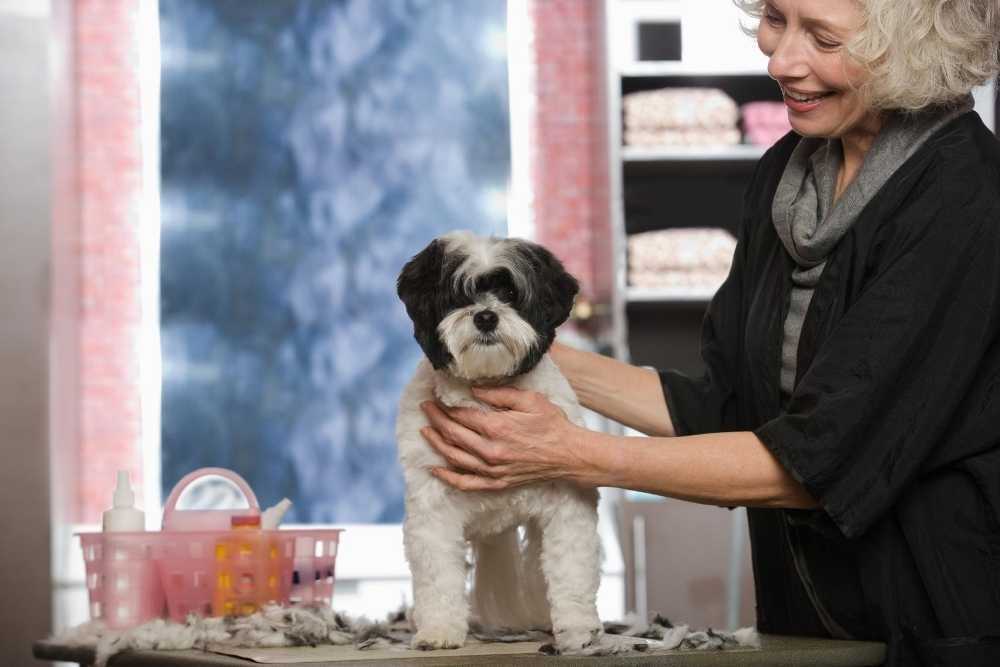
As there is going to be a lot of loose hair involved, you’ll need to brush your dog somewhere that all that shedding won’t matter, like in the backyard or out in the garage.
If neither of those are available having your dog stay on a sheet or drop cloth that can be gathered up and contain all the loose hair is an option as well.
When brushing your dog for the first time do so very carefully, as some dogs have areas on their body that they do not react well if they are brushed (often on the belly and near the groin). Until you know how your dog behaves when being brushed proceed with caution!
When brushing, start at the head and work downwards. Use firm but gentle strokes and talk to and praise your pup throughout the process.
If you encounter tangles work them out slowly and gently, using both the dog brush and, if needed, your fingers. Don’t yank or pull the tangles out though, even if they seem loose, as doing so can rip your dog’s skin and cause them pain and injury.
If a tangle is particularly stubborn (it happens, especially if a pup has very long, thick hair) do not be tempted to cut it off yourself as, once again, you could seriously injure your pup. Instead, ditch the DIY dog grooming for now and take her to a professional dog groomer to work it out for you.
How Often to Groom a Dog?
Unlike humans, dogs really don’t need to be groomed every day (although some would not mind).
How often they do need to be brushed varies according to their coat but a typical grooming schedule can be broken down as follows:
- Smooth short hair – Dogs with short, smooth hair can only need to be brushed every month or so to remove dead skin and what little loose fur they may have. This applies to breeds like the Boston Terrier, Beagle and Great Dane.
- Coarse short hair – If your short haired dog has a coarser coat then she should be brushed once every two weeks, as even though they don’t have much fur its texture does make it more prone to knots and tangles.
- Long hair or ‘double coat’ - These dogs need to be brushed at least once a week. Their fur is likely to tangle more easily, and double coated dogs – like the Border Collie – are more prone to developing dead skin faster as well.
When your dog is a puppy you should be even more cautious about brushing too hard or too fast, but you can start gentle brushing early, as doing so will not only keep their coat in better shape but also get them used to being handled for something other than cuddles and pets, which will be a big help for all those essential vet visits soon to come!
Brushing Your Dog’s Teeth
Brushing their dog’s teeth is the grooming task that pet parents dread most, usually because they are sure it will be very hard. The big problem with that though is that, if neglected, of all the grooming needs your pup has this one can damage her health the most.
Why Do I Need to Brush My Dog’s Teeth?
Like humans, dogs are susceptible to developing dental plaque.
No, they don’t eat sticky sweets and candies (or they should not anyway) but any food debris can lead to the formation of plaque on their teeth, and, if left to harden that plaque leads to cavities and gum disease, just as would be the case for you if you did not brush your teeth.
These conditions can be very dangerous to dogs, as gum disease especially can lead to infections in other parts of their body and even to death.
When you visit the vet for a checkup, they will usually clean and descale your pup’s teeth, but in between visits keeping their teeth clean is up to you.
How to Brush Your Dog’s Teeth Safely
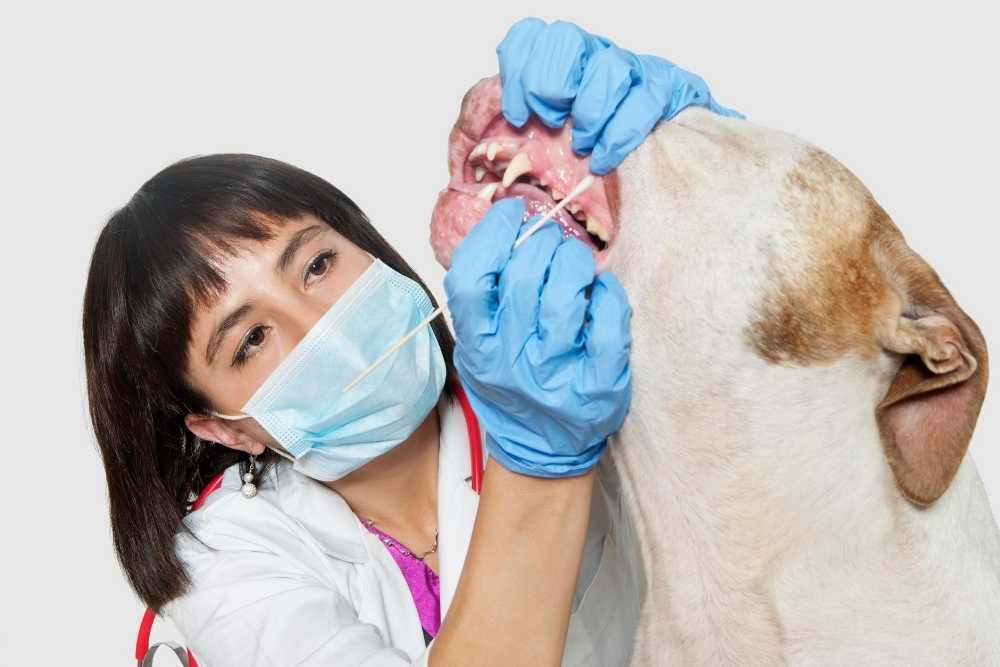
The good news is that you may not need to brush your dog’s teeth every day.
There are a number of special treats on the market they can be given that help keep teeth clean and prevent the formation of plaque, while also keeping their doggie breath fresh.
Our pups love Greenies, as do many other dogs. These treats can be purchased according to your pup’s size and, in addition to helping keep their teeth clean they also contain extra vitamins and minerals to help boost their overall health. And, if our pup’s reaction is anything to go by, they must taste rather good as well.
In addition to treats you can also buy water additives to help keep your dog’s teeth clean and healthy. Arm & Hammer dental water additive harnesses the natural cleaning power of baking soda and has no taste or smell, so should go undetected by your pup.
However, even making use of these things – which is a great idea – does not mean you can skip cleaning your dog's teeth at least once or twice a week. And that is a scary prospect, as even the sweetest pup may nip is scared by having a brush forced into their mouth.
To safely clean your pup’s teeth, follow this (simpler than you might think) basic process:
Only use a special dog toothpaste, never a human one.
Human toothpaste contains ingredients that are not good for dogs. There are lots of toothpastes to choose from, and most contain similar ingredients, so, just like you would for a human kid, try to find one that has a flavor your pup will enjoy.
Before you begin give your pup a small taste of the toothpaste, so they can get used to the taste.
Praising them all the time very gently lift their lip to expose their gums and teeth.
Brush carefully - light strokes - but only try to clean the outside surfaces of their teeth and gums, as it's the very rare pup that will tolerate having the inside surfaces of their teeth cleaned. Make sure you clean all their teeth too, even the ones at the back.
When you are done, reward your pet with a tooth friendly treat.
If your pup does react very badly to your tooth cleaning attempts, enlist the help of your vet.
They can clean your pup's teeth for you and then guide you through the best way to clean your unique pup's teeth yourself, or what other routines you can establish to help keep their teeth cleaner even if your pups refuses to have her teeth cleaned at home.
A Word About Your Dog’s Nails
The chances are that you may have seen a few home devices to clip your dog’s nails advertised online and on TV.
Most dogs do a great job of keeping their nails short thanks to daily walks, but there is no doubt that occasionally your pup’s nails will need a trim.
In the case of puppies, they should have have an initial nail trim, after which trim them as you would the nails of an adult dog.
However, this is the one grooming essential that really is best left only to the pros.
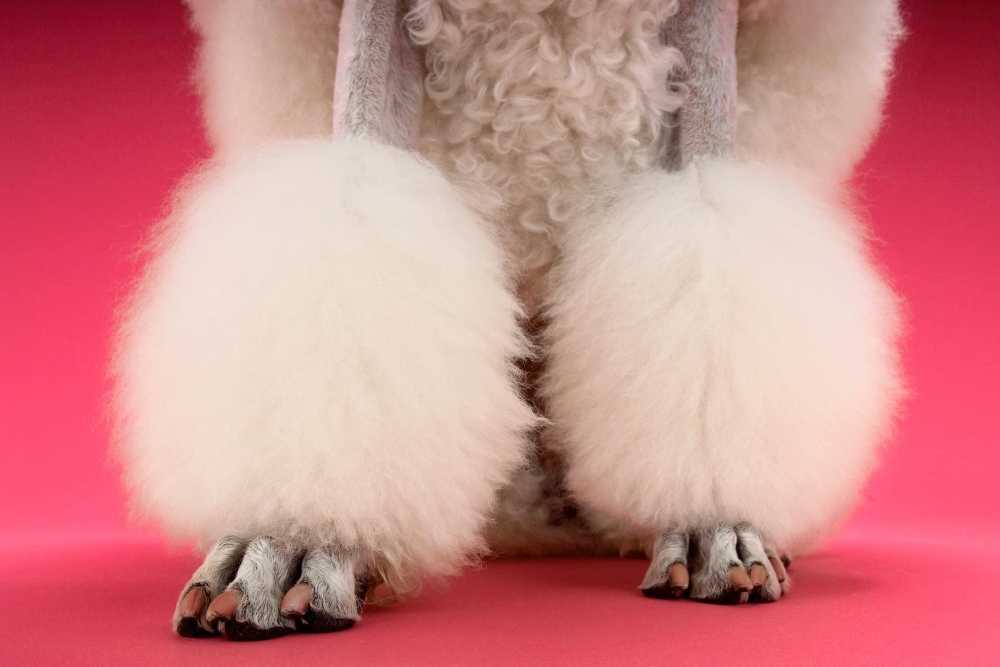
Not only will your dog almost certainly struggle and object to the nail clipping process but even if they are calm a single slip with sharp nail trimmers can do serious and lasting physical harm.
Your pup’s nails contain sensitive tissue and blood vessels, and one wrong cut can be disastrous.
What you can consider for a pup whose nails grow fast, and who is comfortable with you touching their paws – is a Dremel style dog nail file. These files can be found in many pet stores and are good for keeping newly trimmed nails in shape between visits to the groomer.
The bottom line: Hopefully you’ve found this guide helpful and are now better prepared to properly groom your pup at home. If you take the time to do so they really will be healthier and happier, as well as look and smell better.
But there’s never any harm in getting professional grooming help when you need it either, even if only as the occasional spa like treat for your precious pup!

